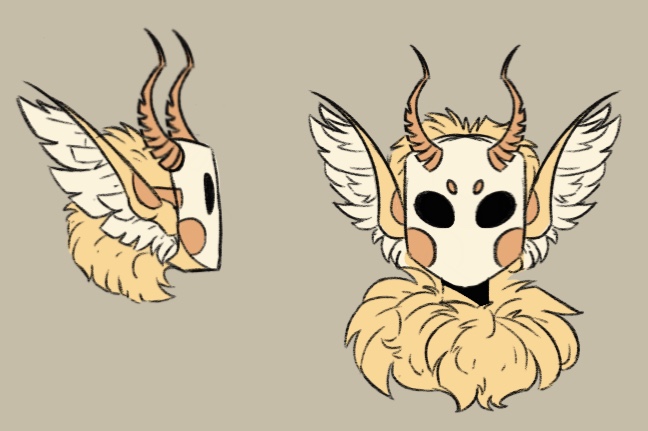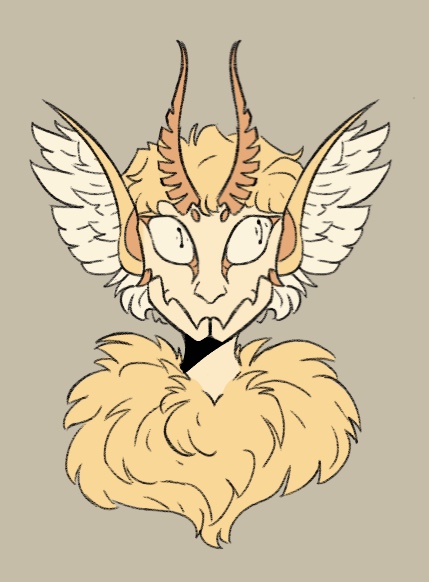Spire Wasplings
Spire Wasplings are the most common variant of Wasplings, surviving in massive nest clusters called that they call Spires.
They are small, sickly-looking insectoid creatures, with very narrow frames and hollow bones. Their forearms and shins are thin and covered with venomous spines, as well as their back, wings, and the end of their tails. Each carries a flat mask woven from plant fiber or carved from bone, to act as a protection against Chatterers, who kill with eye contact. Under the masks, their faces are strange and alien, with huge slitted eyes and sharp mandibles, more insect than human but with an unnerving mix of the two.
Their most striking traits are their wings, large and bug like, covered by a spiny case, and the thick fluff of fur around their necks. They are covered in shell-like plates and yellowish skin.
Abilities-
Wasplings lack a signature magical ability, though they are somewhat capable of learning magic. It is, however, difficult to learn magic in the Wastes, as teachers are non-existent, and mages or enchanters are highly valued and respected due to their rarity. But they can fly, making them one of the only two sentient species with the ability to do so. Unlike Talrathi, who favor a steady pace, Wasplings expend a lot more energy in flight but are incredibly agile, capable of hovering and flying in any direction. In battle, this ability to maneuver in the air makes Wasplings invaluable.Diet-
Food is scarce in the Wastes, and even scarcer when food has to be divided between hundreds of hive members. The only advantage to the Warm Wastes is that it has no cold season, and farms can be maintained year-round. Some examples of staple Waspling foods are- Finchweed- A hardy plant that grows almost anywhere, and grows very quickly. Almost no farm maintenance is required, as they thrive with little intervention. They aren't the most nutritious or filling, but their supply makes up for it. Malrin flowers- Also quite hardy, and decently fast growing, though they require a bit more maintenance. Malrin petals have a pleasant lemony taste, and the seeds can be ground into flour and baked into flatbread. Shell parasites- Wasplings, along with Mothrai, are the only species who will willingly eat Shell parasites. The spider-like creatures are small, but they don't eat much and once they reach maturity, they lay hundreds of eggs a year. Shell parasite eggs- An...acquired taste, even among Wasplings. The closest thing to a delicacy that they have, and is only served during very important events or celebrations.Nesting and Reproduction-
Rather than giving birth to live young, Wasplings lay clusters of eggs in rooms located near the center of the Spire Nest. Waspling eggs need to be kept at a high temperature to survive, and are quite fragile, so this location both keeps them warm and protects them. It is also why Wasplings have fluffy ruffs around their necks- during laying season, the fur moults and falls off, ready to be used as insulating down. Over the course of the next year, the fur grows back. Wasplings form close bonds with caretakers, but blood ties aren’t very important to them. The chaotic nature of egg rooms means that identifying the biological parents of hatchlings is difficult and usually more trouble than it's worth. The owner of the fur that the egg was insulated in, however, is far more important. The fur gives both egg and hatchling a unique scent that matches the fur-giver, and so they can be matched easily. The fur-giver is seen as the true owner of the baby, not the biological parent, leading to very mixed families. Though hatchlings often have just one parent, some Wasplings choose to raise hatchlings communally, most often with their partners.Temperament and bonds-
Wasplings form close bonds in small groups, but their general empathy outside of those groups isn’t very high. The Wastes are harsh, and death is common, so making a big fuss about strangers is seen as silly. Because of this, and paired with their naturally analytical natures, they can seem quite cold to strangers. Wasplings are also very rare outside of the Wastes, making them highly mysterious. Some don't believe they exist at all, thinking they are just urban legends or fairy tales.Threats-
The main threats to Spire Wasplings are starvation and Chatterers. The Warm Wastes are infested with the creatures, and they see Wasplings in large groups as easy pickings. They are why Spire nests are built hundreds of meters aboveground, so the Wasplings can see them early and raise alarms to get back inside. Starvation is harder to combat, as safety in numbers doesn’t work so much. There are almost no consistent sources of food in the Wastes, and farms need water, which needs to be brought up from deep underground.Trivia-
Interestingly, an unmasked Waspling triggers an extreme fight-or-flight response in Nevians. Nevians become unnerved by things that look like them but not quite right, and the facial structure of Wasplings is similar yet different enough to them to register as a threat. Though Wasplings cannot consciously alter their appearance, they are capable of 'Masking'- appearing to other species as more human than they actually are. This doesn't help their popularity, however, as Masking is a trait commonly associated with predators, most notably Chatterers. (A partially Masked Waspling. Note the unnatural mix of features.)Nests-
Spire Wasplings live in massive, layered nests hundreds of feet above the ground, built around the strange tall pillars found in the Warm Wastes. Each nest tends to follow a similar format, with certain sections of the nest used for different things. The nests themselves are usually found either alone or in small clusters of 2-3Remove these ads. Join the Worldbuilders Guild











Comments